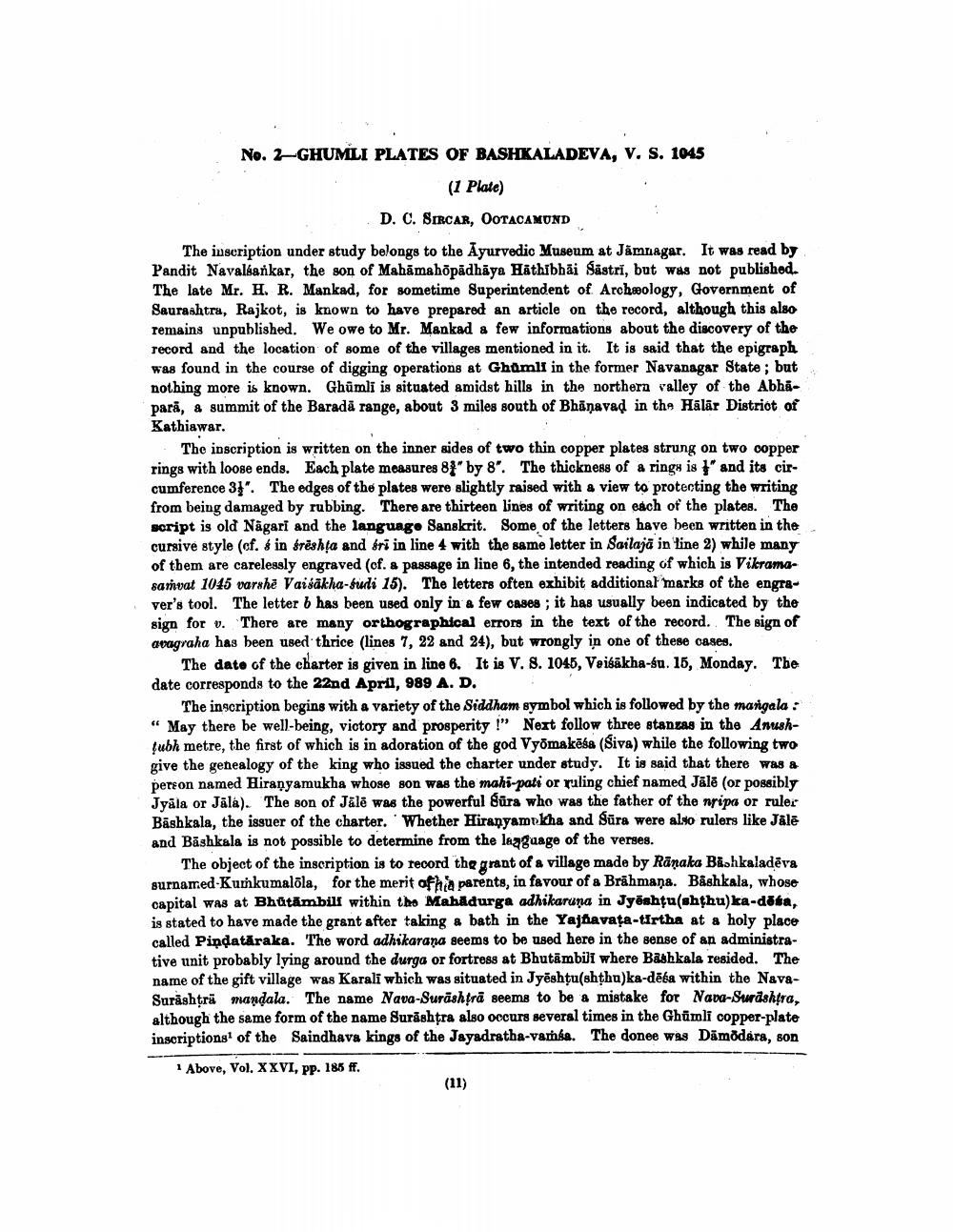________________
No. 2-GHUMLI PLATES OF BASHKALADEVA, V. S. 1045
(1 Plate)
D. C. SIRCAR, OOTACAMUND The inscription under study belongs to the Ayurvedic Museum at Jamnagar. It was read by Pandit Navalóankar, the son of Mahāmahõpādhāya Hathibhāi Šāstrī, but was not published. The late Mr. H. R. Mankad, for sometime Superintendent of Archeology, Government of Saurashtra, Rajkot, is known to have prepared an article on the record, although this also remains unpublished. We owe to Mr. Mankad a few informations about the discovery of the record and the location of some of the villages mentioned in it. It is said that the epigraph was found in the course of digging operations at Ghumll in the former Navanagar State ; but nothing more is known. Ghümli is situated amidst hills in the northern valley of the Abhapară, & summit of the Baradā range, about 3 miles south of Bhänavad in the Hālār Distriot of Kathiawar.
The inscription is written on the inner sides of two thin copper plates strung on two copper rings with loose ends. Each plate measures 81" by 8'. The thickness of a ring is ' and its circumference 31". The edges of the plates were slightly raised with a view to protecting the writing from being damaged by rubbing. There are thirteen lines of writing on each of the plates. The script is old Nägari and the language Sanskrit. Some of the letters have been written in the cursive style (cf. & in freshta and bri in line 4 with the same letter in Sailaja in line 2) while many of them are carelessly engraved (cf. a passage in line 6, the intended reading of which is Vikramasarvat 1045 varshe Vaisakha-fudi 15). The letters often exhibit additional marks of the engraver's tool. The letter b has been used only in a few cases; it has usually been indicated by the sign for v. There are many orthographical errors in the text of the record. The sign of avagraha has been used thrice (lines 7, 22 and 24), but wrongly in one of these cases.
The date of the charter is given in line 6. It is V. 8. 1045, Veisakha-su. 15, Monday. The date corresponds to the 22nd April, 989 A. D.
The inscription begins with a variety of the Siddham symbol which is followed by the mangala : “ May there be well-being, victory and prosperity !" Next follow three stanzas in the Amushtubh metre, the first of which is in adoration of the god Vyoma kēša (Siva) while the following two give the genealogy of the king who issued the charter under study. It is said that there was a person named Hiraṇyamukha whose son was the mahi-pati or ruling chief named Jālē (or possibly Jyala or Jala). The son of Jālē was the powerful Gura who was the father of the nipa or ruler Bashkala, the issuer of the charter. Whether Hiranyamukha and Sūra were also rulers like Jale and Bāshkala is not possible to determine from the language of the verses.
The object of the inscription is to record the grant of a village made by Ränaka Bishkaladeva surnamed-Kumkumalola, for the merit of a parents, in favour of a Brāhmaṇa. Båshkala, whose capital was at Bhatambill within the Mahadurga adhikaruna in Jyoshtu(shthu)ka-data. is stated to have made the grant after taking a bath in the Yajnavata-tirtha at a holy place called Pindatāraka. The word adhikarana seems to be used here in the sense of an administrative unit probably lying around the durga or fortress at Bhutāmbili where Bashkala resided. The name of the gift village was Karali which was situated in Jyēshtu(shthu)ka-deba within the NavaSurāshtrü mandala. The name Nava-Surāshtrā seems to be a mistake for Nava-Surashtra, although the same form of the name Surashtra also occurs several times in the Ghümli oopper-plate inscriptions of the Saindhava kings of the Jayadratha-vamia. The donee was Damodara, son
1 Above, Vol. XXVI, PP. 185 ff.
(11)




